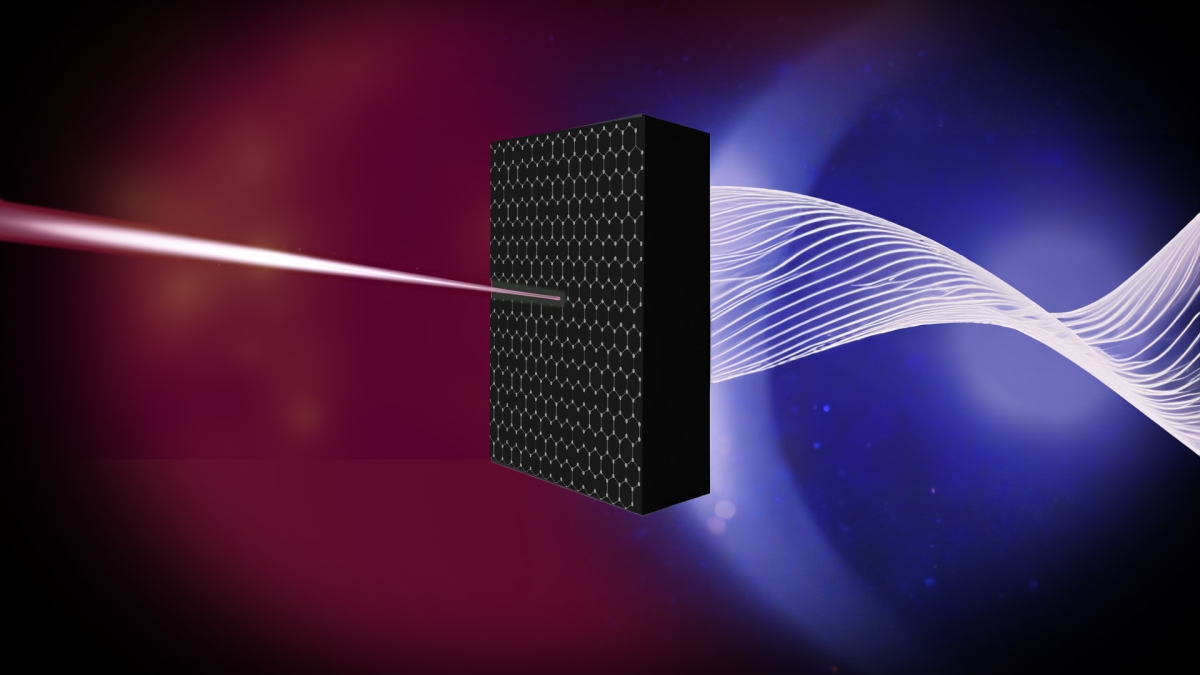ASU research team develops breakthrough ultrashort laser pulse technology

Yu Yao, an associate professor of electrical engineering, has developed a method to detect optimal target locations for lasers to improve time and energy usage by several orders of magnitude. Graphic by Erika Gronek/ASU
From communication and entertainment to manufacturing and health care, lasers have revolutionized the way we interact with the world around us. They have become an integral part of our modern existence, pushing the boundaries of innovation as indispensable components of countless devices and industries.
Lasers produce narrow beams of light. When the laser’s light interacts with the surface of a material on a nanoscale, it emits a wave of light known as a plasmon, and the attributes of a given plasmon can signal information. In optic transmission, a laser pumps light at a component called a saturable absorber to generate an optical signal.
Yu Yao is an associate professor of electrical engineering in the School of Electrical, Computer and Energy Engineering, part of the Ira A. Fulton Schools of Engineering at Arizona State University. She and her research team at the ASU Center for Photonics Innovation designed a faster and more energy-efficient nanoscale laser component called the graphene-plasmonic hybrid metastructure saturable absorber, known as GPSMA.
GPSMA has potential applications across communication, information processing, spectroscopy and biomedical industries. The absorber can be used to enhance the speed, efficiency and overall performance to advance data transmission, information processing, biomedical sensing and imaging technologies.
Yao’s team has been incorporating an artificially engineered metal-graphene hybrid material in their work due to its beneficial traits in optical modulation and saturable absorption.
In a recent publication in the scientific journal ACS Nano, Yao details her lab’s integration of graphene-based saturable absorbers and how they managed to refine the device to reduce power consumption while maintaining ultrafast response times.
They achieved these significant results by designing an optic antenna array that focuses light into the nanoscale gaps of the material, known as hot spots, to boost absorption. By focusing the laser on these hot spots, they observed improved performance and decreased energy usage.
“Graphene is lightweight and has a fast optical response time but has a low absorption rate in monolayer form,” Yao said. “We designed this device so that light absorption in the nanoscale hot spot can be increased by over three orders of magnitude, resulting in not only strong light absorption but also saturable absorption effects. With GPSMA, we are making a saturable absorber device that could actually reduce power consumption by almost two or three orders of magnitude.”
Their new technique is opening opportunities for infrared laser spectroscopy and high-speed optical signal communication with both fiber-optic cables and satellite communication due to its speed.
“Our device can operate at record-high speed,” Yao said. “Conventional saturable absorbers can operate at nanosecond time scales, but now we’re getting to approximately 60 femtoseconds, which is over 100,000 times faster.”
GPSMA is currently operated at near-infrared wavelength on the electromagnetic spectrum. Thanks to the broad optical response of graphene, it is possible to extend its spectral coverage to longer wavelengths in the infrared spectral region, which are of great interest for molecular spectroscopy and optical communications. Yet, for the longer wavelengths, it is conventionally more difficult to achieve saturable absorbers and generate ultrashort laser pulses. The GPSMA design concept could fill this technological gap.
Yao’s device has potential applications across telecommunications, energy and biomedical industries. The absorber can be used to enhance the speed, efficiency and overall performance of fiber-optic cables, opening opportunities to advance data transmission, solar cell performance and imaging technologies for disease detection.
More Science and technology

ASU professor wins NIH Director’s New Innovator Award for research linking gene function to brain structure
Life experiences alter us in many ways, including how we act and our mental and physical health. What we go through can even…

ASU postdoctoral researcher leads initiative to support graduate student mental health
Olivia Davis had firsthand experience with anxiety and OCD before she entered grad school. Then, during the pandemic and as a…

ASU graduate student researching interplay between family dynamics, ADHD
The symptoms of attention deficit hyperactivity disorder (ADHD) — which include daydreaming, making careless mistakes or taking…